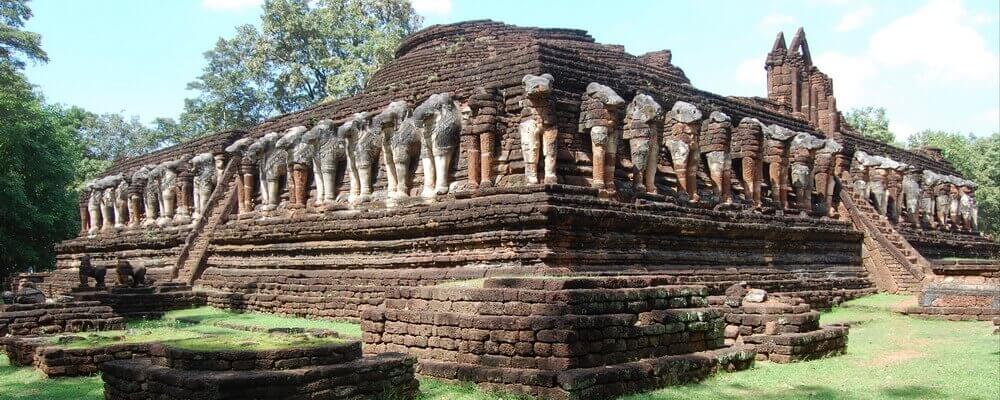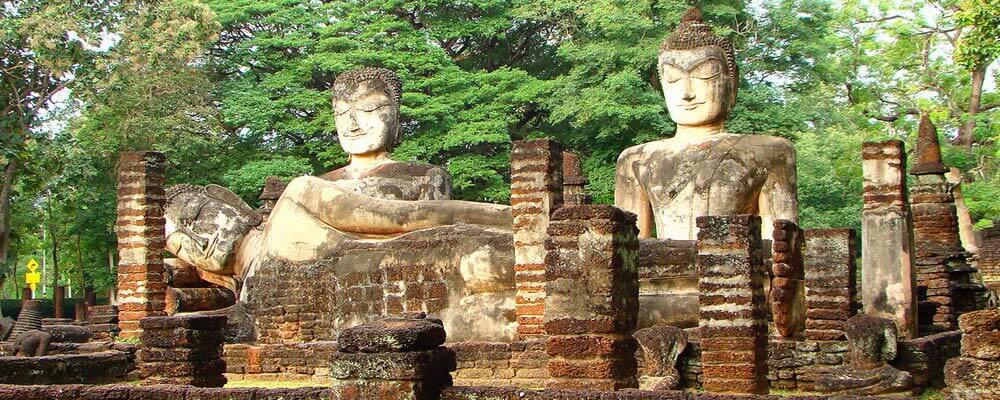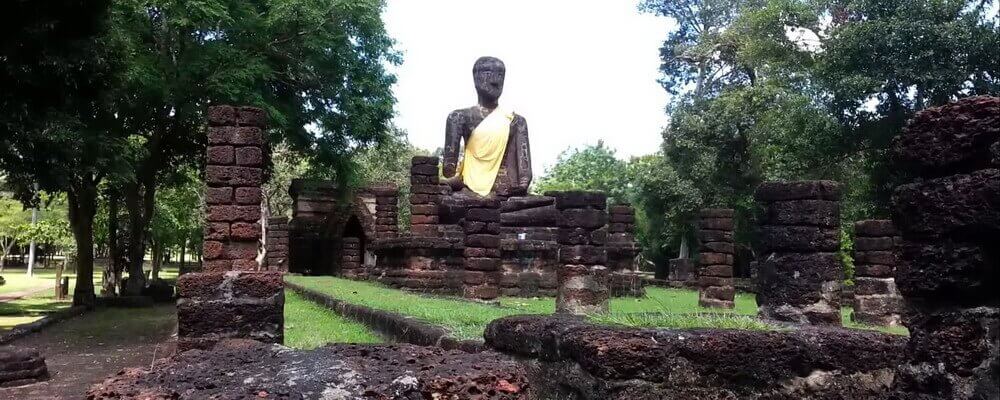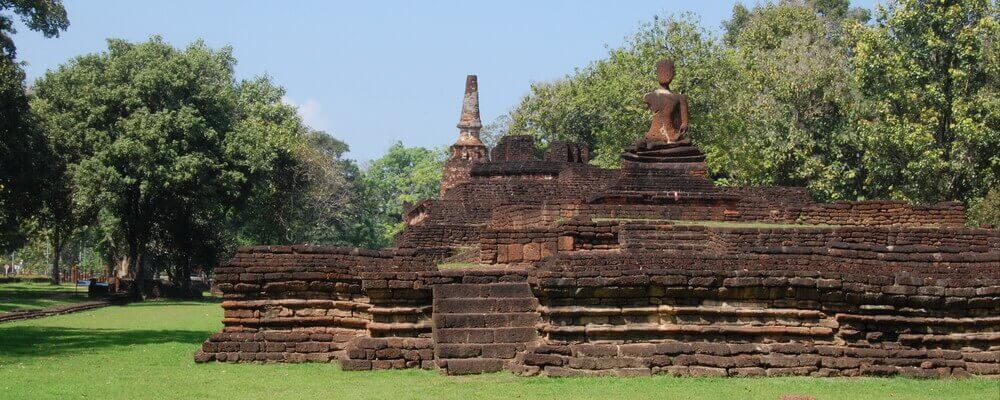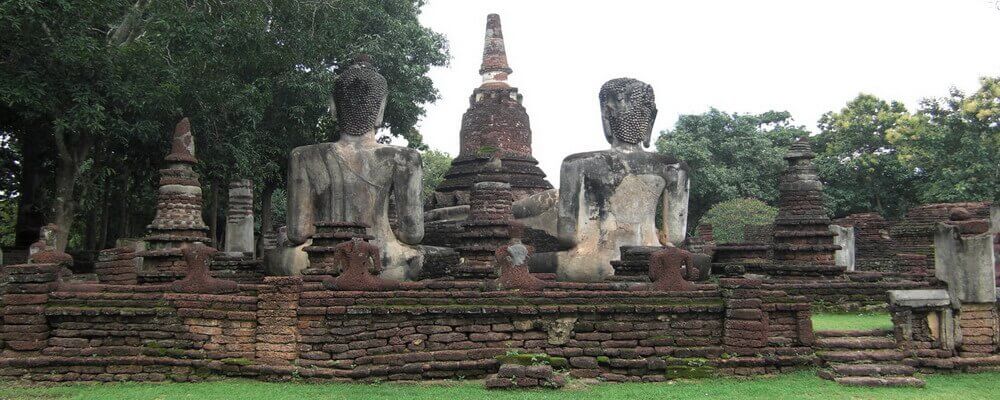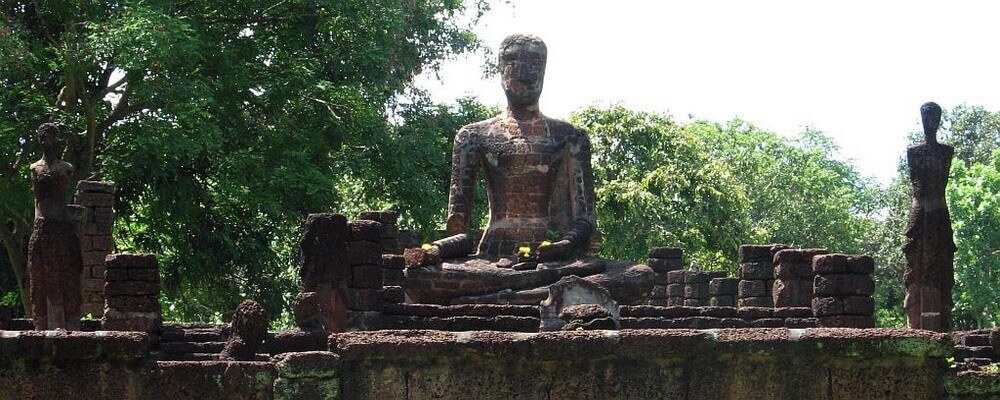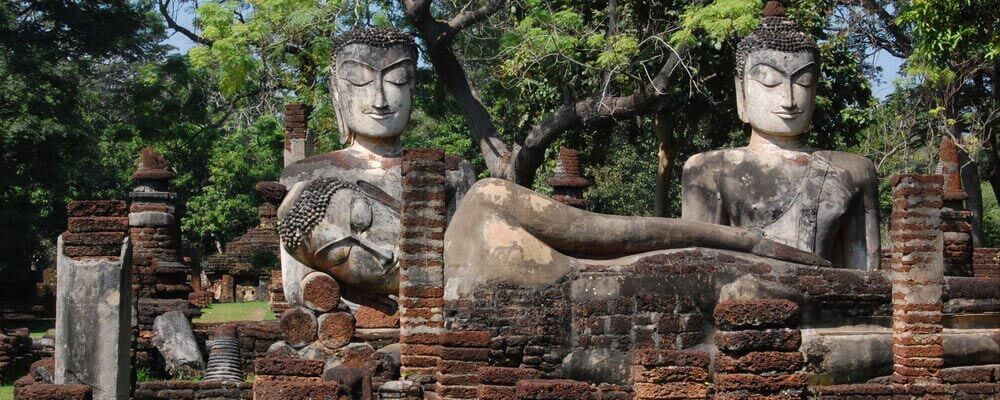 Kamphaeng Phet Historical Park
Kamphaeng Phet Historical Park
Kamphaeng Phet Historical Park contains the ruins of Kamphaeng Phet, an important city during the Sukhothai and Ayutthaya Kingdoms. The name Kamphaeng Phet, which literally translates into wall of diamond, derives from the imposing walls that defended the city. Its historical ruins, temples, palaces and city walls, in laterite and bricks date back to a period from the 13th to the 17th century. The top of the structures, walls and wood roofs, have been lost. The park in December 12, 1991 was declared a World Heritage Site by UNESCO, along with the historic parks of the ancient capital Sukhothai and Si Satchanalai. Ancient chronicles report that around 1157 the city of Cha Kang Rao was built on the eastern bank of the Ping River by the Khmer, during their dominoes on the area, as a military town border. The city was expanded during the Sukhothai Kingdom, and used as a Wang, garrison town, to defend the capital from the continuous invasions of the enemy armies. The defensive system of the Kingdom was secured by several garrison towns, the most important were: Cha Kang Rao at west, Si Satchanalai at north and Phitsanulok at east. During the reign of Phra Maha Thamma Racha I, King Li Thai 1347 - 1368, was built Nakhon Chum, a new city on the west bank of the Ping River, where was moved to the political and administrative centre. Later, during the decline of Sukhothai Kingdom, the city was placed under vassalage by the emerging Ayutthaya, keeping the characteristic of garrison city to protect its capital, from the pressing forces of Burma. King Borommaracha of Ayutthaya, 1370 - 1388, combined the cities of Cha Kang Rao and Nakhon Chum and called the whole Kamphaeng Phet, moving back the political and administrative centre in the area of the walled city. Kamphaeng Phet was located in one of the most strategic positions but also the most exposed of the Kingdom. Its defence system with moats, massive walls, towers and fortresses had to withstand the impact of Burmese army many times throughout its history. After the defeat of Ayutthaya Kingdom in 1567, by the Burmese army, Kamphaeng Phet was abandoned by the population. People are reinstated later, after the war, only outside the city walls. Kamphaeng Phet Historical Park consists of four archaeological sites: Mueang Cha Kang Rao, the area of the ancient walled city to the east of the Ping River, Aranyik, the wooded hilly area of city, about a Km north of the walls, Mueang Nakhon Chum, the city area located to the west of the Ping River, and Mueang Trai Trueng, a smaller area about 18 Km south-west of Kamphaeng Phet. Mueang Cha Kang Rao, the ancient name of Kamphaeng Phet, had the same town planning concept of Sukhothai and Si Satchanalai, with separate zones for religious sites and administrative both within and outside of the confines of the city walls. Walls, moats and fortifications mark the border of Muang Cha Kang Rao, the old walled city, of irregular trapezoidal shape, which varies in width from 300 to 700 meters and a length of 2200 meters. Inside the walls lie the few ruins of the Royal Palace and the most important temples of the Park, the Wat Phra Kaew and Wat Pra That. The Aranyik hill is a pleasant surprise for visitors to the park for the richness of the historical artefacts, although many are simple mounds of rubble, and the lush jungle that surrounds these. On the wooded hill are the remains of more than 40 temples, including the most beautiful are the Wat Awat Yai, Wat Singh, Wat Chang Rop, Wat Phra Non and Wat Phra Si Iriyabot. The structures, in all the areas of the park, denote influences architectural of Sukhothai and Ayutthaya eras. One difference you notice immediately in the ruins of Cha Kang Rao, and Aranyik, and those found in the Park of Sukhothai is the great use of laterite, in place of brick or stone for the construction of buildings but also to construction statues and images of Buddha. The erosion of this brittle material has caused the loss of the arms, of parts of the body and of the characteristics of the face in most of the statues, with a final result like ghosts or aliens. Unlike the temples on the east side, the religious sites on the west bank of the Ping River, in Mueang Nakhon Chum are built mainly of brick, fewer and smaller.
Admission & opening hours: the park opens daily from 08:00 until 18:00. The Park is divided in two areas, old city walls and Aranyik, price for one or other area is 100 THB, but it’s possible to buy a single ticket for 150 THB that gets you into both sections.
Getting around Park: the central area of Park, inside the old city walls, is small, the area can be easily explored on foot. The Aranyik area is located just outside the city walls, about 1 km, and can be reached on foot. One option to get around between the two areas of the park is rent a bike at the gates of the central city area and Aranyik area, it costs is about 50 THB per day.Read More
Info
- Address: Tambon Nong Pling, Kamphaeng Phet
- Telephone: +66 5585 4736
- Website: www.tourismthailand.org
Dinamic Map
Kamphaeng Phet Historical Park Highlights
Wat Phra Kaew was the largest temple complex of ancient Kamphaeng Phet. The temple was built during the 15th century in the centre of the old walled city, Cha Kang Rao, parallel to the river Ping. Wat Phra Kaew was located near the Sa Sun, the Royal Palace, was the Royal temple, where the King paid homage to the Buddha, and was the site of the most important ceremonies in the city. The temple consisted only of the area Buddhavasa, one dedicated to real worship and ceremonies, but was devoid of the area Sanghavasa, the part normally dedicated to residence for monks, the same concept used in the Wat Phra Si Sanphet in Ayutthaya and then taken up in Wat Phra Kaew in Bangkok. The monks were allowed into the temple, at the invitation of the King, only for ceremonial occasions. According to an ancient text, in Wat Phra Kaew of Kamphaeng Phet have been preserved, for an unspecified period, two of the most revered and valuable images of Thai Theravada Buddhism, the Phra Phuttha Sihing and the Phra Kaeo Morakot, known as the Emerald Buddha, now kept at Wat Phra Kaew in Bangkok. The name of temple in Kamphaeng Phet was awarded by King Mongut, during the period when he was still Crown Prince, because the temple had preserved Phra Kaeo Morakot during the era of Ayutthaya. The architectural styles of the temple indicate that its facilities have been built and expanded over the centuries. The structures of the temple, enclosed by a wall of large blocks of laterite, include a main chedi, most viharns, two mondops and several dozen smaller chedis. The main chedi has a base decorated with lions, surmounted by a further base surrounded by elephants holding up a bell-shaped chedi. The area is surrounded by laterite walls that contain the ruins of other smaller chedis and several chapels. Of viharns and mondops remain in practice only the bases in laterite, and several statues, also in laterite, for most severely eroded by time. In a viharn there are three Buddha images best preserved, in brick covered with stucco, dating back to the Ayutthaya period. Two images are representations of the Buddha in the position of Bhumisparsha, Calling the Earth to Witness, and one is in a reclined position, Phra Non. In the eastern corner of the temple stands a large base of laterite, which claimed several structures including a viharn with a large Buddha image laterite very eroded. On the usual basis is a structure with jagged edges, which is assumed to be a kind of throne where he was kept the Phra Kaeo Morakot.Read More
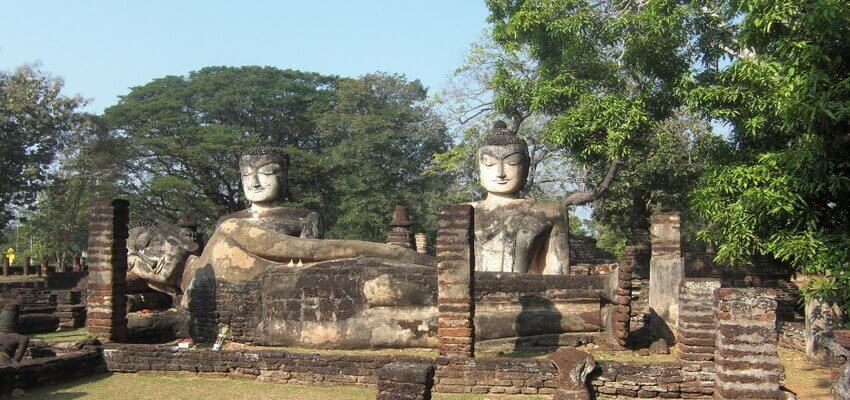
Wat Phra That is the second most important temple in the walled part of Kamphaeng Phet Historical Park. The temple, dating from the 15th century, is located adjacent to the Wat Phra Kaew in Cha Kang Rao area, and was intended to preserve some sacred relics of the Buddha. In Thailand they are appointed Wat Phra That or Wat Mahathat the temples that enshrine in their main chedi the relics of the Buddha. Wat Phra That in Kamphaeng Phet, as the nearby Wat Phra Kaew, consisted only of the area Buddhavasa, the area dedicated to the veneration of Buddha and the ceremonies, but without the Sanghavasa area, the residence of the monks. The structures of the temple include a main chedi, a viharn and two chedis minor, and are surrounded by a brick wall. The main chedi, what preserved ancient relics, is a classic bell-shaped chedi with a large square base of 15 meters. The chedi was built in brick and laterite and was originally covered with stucco, in the architectural style of Sukhothai, and is in good state of preservation. Of the viharn, the Assembly Hall of the temple, remain only the base and some of the pillars that supported the roof. Behind the viharn are two bell-shaped chedis smallest, constructed of brick. The southern one is better preserved, the top of the north collapsed.Read More
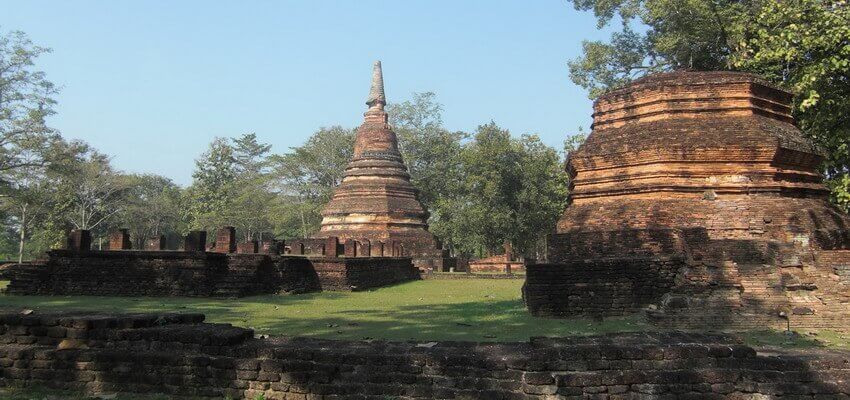
Wat Awat Yai, or Wat Avasa Yai, is 2 km north of the walled area of the Kamphaeng Phet Historical Park, in the area of forested hill Aranyik. The temple dates back to a period between the 15th and 16th century, in the heyday of Ayutthaya Kingdom. Wat Awat Yai includes a Buddhavasa, the area dedicated to the worship and ceremonies, enclosed by a perimeter wall, and a Sanghavasa, the residence of the monks, outside the walls of the temple. The temple consists of a main chedi with an octagonal base, a Ubosot, a main viharn, a viharn smaller and a large number of smaller chedis. In front of the temple it is also a large pond, called Bo Sam Saen, which was dug into the ground and covered with laterite. The most interesting structure of Wat Awat Yai is what remains of its main chedi, located behind the ruins of the main viharn, in the midst of Buddhavasa area. The imposing octagonal base, 16 meters wide on each side, is very high and sustained an equally majestic chedi, probably a bell-shaped, which is unfortunately collapsed. Of the other structures, as the main Viharn, the Assembly Hall, the smaller viharn and the Ubosot and Ordination Hall remain only the foundations and some of the columns that supported the wooden roof. At the front of the temple there are the ruins of two L-shaped platforms, both topped by eight small chedis, some circulars other with notched corners.Read More
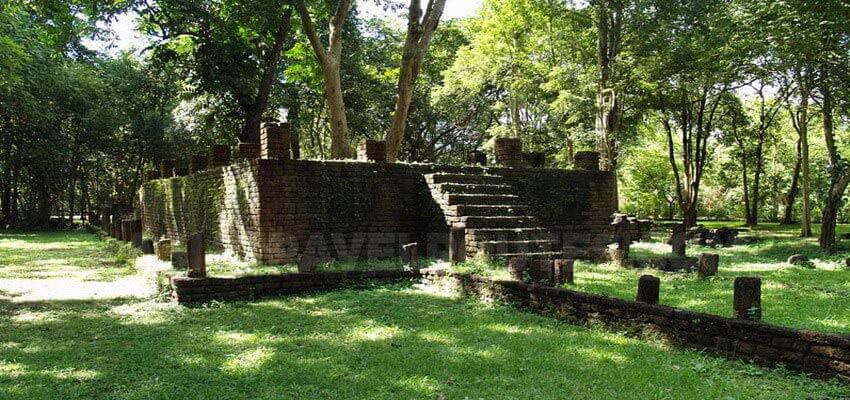
Wat Singh is located on the hill Aranyik, one km north of the ancient walled area of Kamphaeng Phet. The temple dates back to a period between the 15th and 16th century, ages between the Sukhothai and Ayutthaya eras. Wat Singh, which literally means Temple of Lions, takes its name from the lion statues that adorned the base of support of its Ubosot. The temple, surrounded by a wall of laterite, contained a Buddhavasa, the area devoted to worship, and a Sanghavasa, the residence of the monks. The most interesting structures of Buddhavasa are the ruins of its Ubosot, known as Bot in Thai, and the square base in bricks of its main chedi. The Ubosot was initially built to be used as viharn, Hall of Assembly and worship, but was later turned into a Hall of Ordination for monks. Of this building remain its base, surrounded by statues of lions and Naga figures, and some rows of columns that supported the roof of wood, completely lost. On the base are the eight stones Sema, strains that marked the sacred area, and, on the back of the ruins of the building, an image of the Buddha in the position Bhumisparsha Mudra, severely eroded. The main chedi, located in front of the Ubosot, has a square-shaped base with large arched niches in each of four sides. Each niche contains an image of the Buddha in the position Bhumisparsha, Calling the Earth to Witness. The base, made of brick, is in good condition of conservation, the upper part bell-shaped is collapsed. The main chedi was surrounded by four small chedis, of which very little is left.Read More
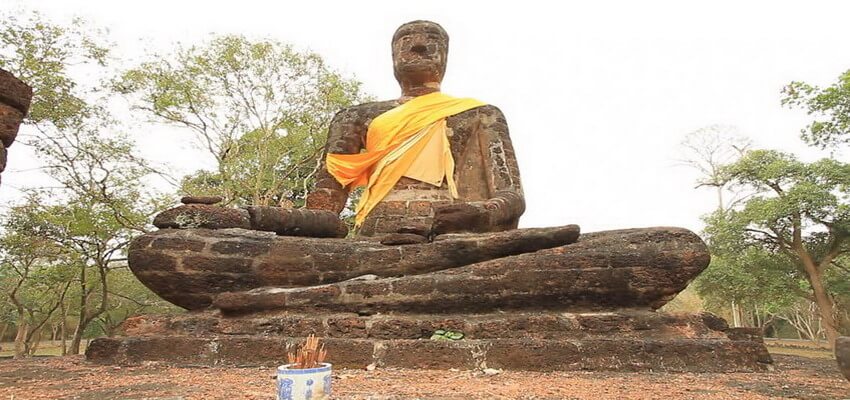
Wat Chang Rop is a temple that sits on top of the wooded hill of Aranyik, one km north of the old city walls. The temple, whose name means temple surrounded by elephants, was probably built in the period between the 15th and 16th centuries, during the eras of Sukhothai and Ayutthaya. The most attractive structure of the temple is its impressive main chedi in Sinhalese style. Other ruins of Wat Chang Rop include a Ubosot, a viharn and several minors chedis. The temple structures are in laterite, cut from a quarry located in front of the temple, later turned into a pool that served as a water reservoir. In front of the pond is all that remains of the viharn, the base and some of the columns that supported the roof. The Ubosot is located in the northeast corner of the temple complex, away from the other, and of this too you can still see the base in laterite, with the Sema stones that surrounded the sacred area, and some columns. The majestic chedi was built on a square base, in good condition of conservation, of imposing measures, 31 meters on each side, surrounded by numerous additional minor chedis, of which remain only a few bases. The highest part of the base is surrounded with 68 statues of half-elephants between which are Bhoti-shaped designs; there are also traces of floral designs, demons and figures of dancers. The body of the elephants, which protrude out of the structure, it seems that supporting the top of the structure. Steep staircases, one on each side of the base, lead to the large platform on top, the centre of which stood the bell-shaped chedi in Sinhalese style. Of great chedi remains only its octagonal base, the rest of the structure has collapsed.Read More
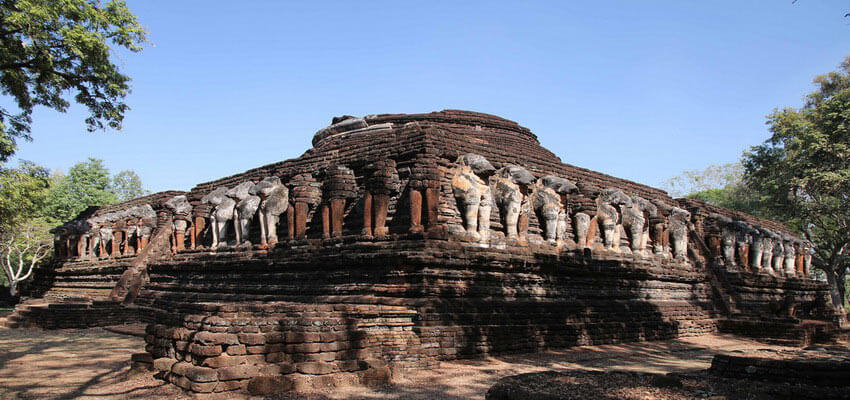
Wat Phra Non is located on the hill Aranyik, the area north of the Historical Park, about a km from the old city walls. The temple, which dates from the 15th or 16th century, owes its name to the image of a Reclining Buddha, Phra Non, who was in its viharn. Wat Phra Non consisted of a Buddhavasa, the area dedicated to the veneration of the Buddha, and a Sanghavasa, the area where lived the resident monks. The Buddhavasa was enclosed in a wall of laterite and included a Ubosot, a viharn, a mondop, a main chedi and several minors chedis. The area Sanghavasa was placed outside the walled area. In front of the temple they were also a pond, bathrooms and a floating pavilion supported by a large laterite column. Of the Ubosot few ruins remain, the base, with the eight Sema stones that surrounded the sacred area, and some octagonal columns in laterite supporting the wooden roof. Viharn is in best storage conditions. More than its rectangular base remain even most of the walls and almost all of the columns supporting the roof, about six meters high and in a single block of laterite. The Reclining Buddha inside, probably built in laterite, has been lost, and remains only its pedestal. The main chedi of the temple was recently renovated. It’s a bell-shape chedi, in classic Sinhalese style, that standing up a square base with different regressive levels. Of the smaller chedis around remain some of the bases.Read More
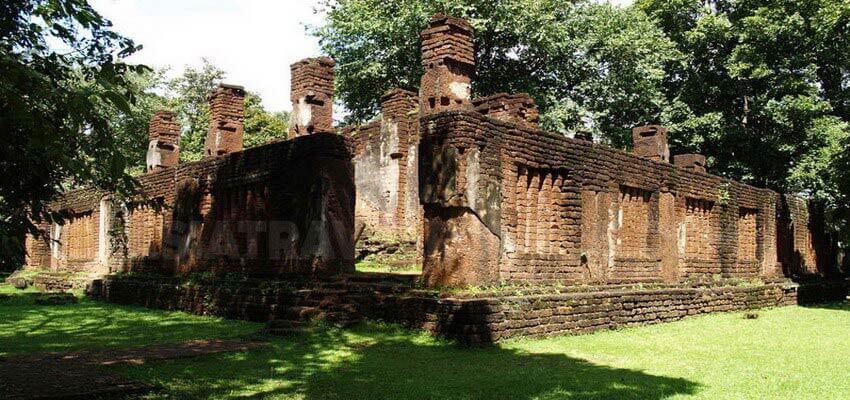
Wat Phra Si Iriyabot, which literally means Temple of the four postures of the Buddha, is located just north of Wat Phra Non, on the wooded hillside of Aranyik. The temple, which dates from the 15th or 16th century, is enclosed by a laterite wall. Buddhavasa, the area devoted to worship, consisted of a small Ubosot, a large viharn and a Mondop. The Sanghavasa area was on the back of the temple. In front of the temple were a pond and bathrooms similar to those of Wat Phra Non. The Ubosot, the ordering hall of monks, was placed near the walls, of it remain very few ruins. Even of big viharn remains little more. The ruins include the great laterite base, two meters high, and some parts of the walls with a few of the columns that supported the roof. The ruins of Mondop are placed behind the viharn, enclosed in a wall with four chedis in the corners. The structure, without roof, has four niches containing the four Buddha images in different postures, Mudra in Buddhist philosophy. Of this four remain in good condition only the image in standing posture, about 9 meters high, of the other, sitting, reclining and walking, very little remains.Read More
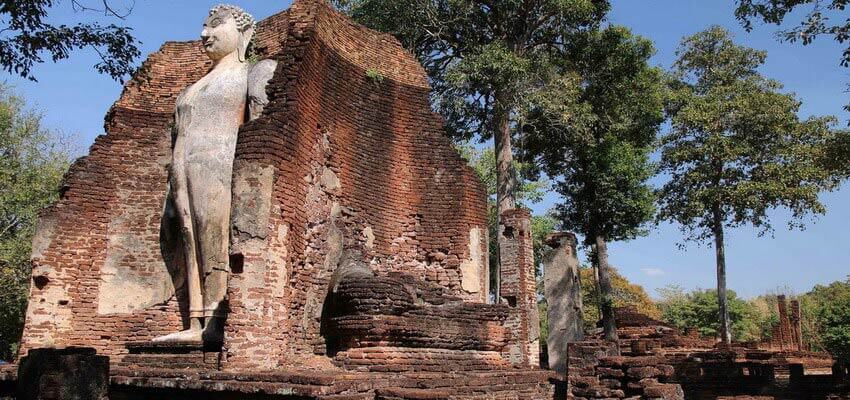
Wat Phra Borom That Chediyaram is a temple located in the centre of Mueang Nakhon Chum, on the west bank of the Ping River, with a beautiful chedi in Burmese-style inside. The chedi was built by Phra Maha Racha Thamma I, King Li Thai, in 1357, as shown by one of the Religious Stone Inscriptions found during excavations in Nakhon Chum. The chedi was originally made of bricks, shaped lotus bud in the style of Sukhothai. During the reign of Chulalongkorn the Great, Rama V, the chedi was renovated and enlarged in Burmese style, with royal permit, by a Burmese trader known as Phraya Taka. On the southern side of the temple is an Ubosot that contains numerous bronze images of Buddha that have been sculpted in Sukhothai and Ayutthaya styles.Read More
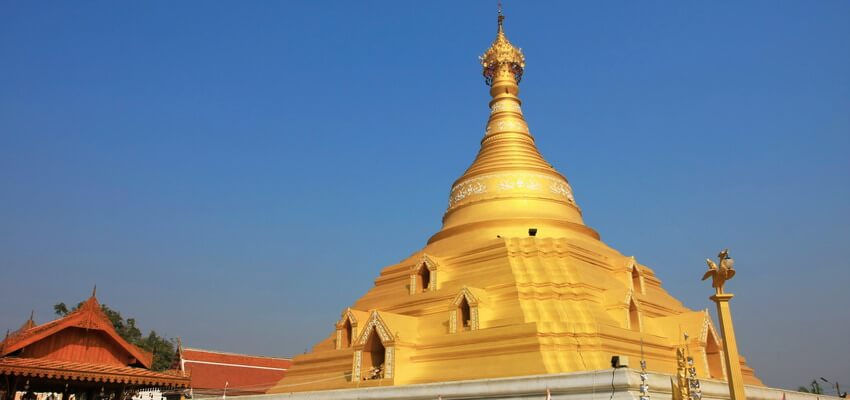
Kamphaeng Phet National Museum is located within the walled part of ancient Kamphaeng Phet, Cha Kang Rao, opposite to Wat Phra That. The museum contains artefacts found during excavations in various sites of Kamphaeng Phet and its province. In the three exhibition areas, garden, ground floor and first floor, you can admire exhibits covering different eras, from prehistory to the late Ayutthaya period, a good selection of Thai art. In the garden area there are replica stucco models of elephants, in Sukhothai style, in the form that usually surround the bases of chedis, heads of Buddha statues, sculptures of demons and celestial beings used to decorate the bases of chedi or Viharn, some bronze canons and stone ware jars. At ground floor some displays give information to the Kamphaeng Phet area, its history art and architecture. The items exposed include pottery, iron and stone artefacts of the prehistory period, coins from the Mon Dvaravati Kingdom period and from Sukhothai and Ayutthaya Kingdom periods. On the first floor you can admire artefacts in bronzes of Hindhu deities, bronzes of Buddha in Sukhothai and Ayutthaya style, ceramic Sangkhalok works from the region. One of the most interesting exhibits is a bronze statue, of the early 16th century, of Shiva. The image high 2.10 meters was found in the close shrine dedicated to the god Shiva. Admission & opening hours: the museum is open from Wednesday to Sunday, from 09:00 to 16:00. Admission is 100 THB.Read More
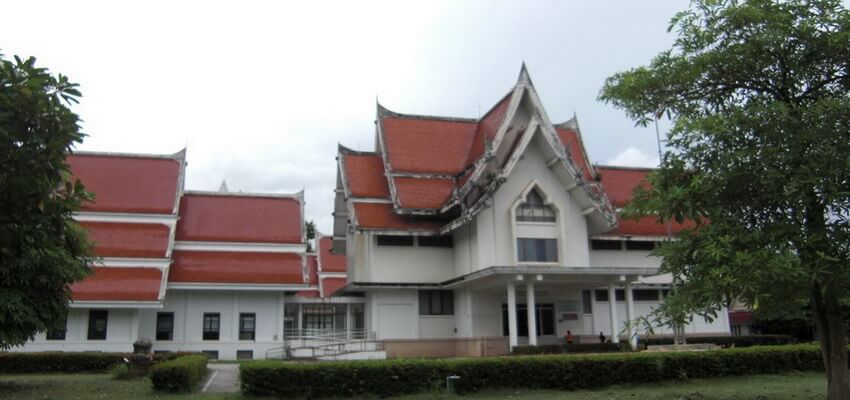
Ancient chronicles report that already in 1004 a town called Muang Trai Trung was located on the bank of the Ping River. The town was built, according to tradition Phongsawadan written during the reign of Rama I, by a group of Thai led by King Chaisiri of Chiang Rai. This population had migrated south, from the area of Chiang Saen in Chiang Rai, pushed by invading Burmese armies in the year 999, and settling in the Kamphaeng Phet area as a haven of war. The town was supposed to be a temporary stay, however, in subsequent years, Trai Trung was occupied by more people, transforming this small town in a city. Later, when Sukhothai became independent from the domain of the Khmer Empire, Trai Trung probably became a vassal of the new Kingdom of Sukhothai. The remains of the city walls are still partially visible today, on both sides of the Ping River. Ditches and earthen ramparts probably belong to the early period of Sukhothai. The ancient Trai Trung had a rectangular shape, parallel to Ping River, with a maximum width of 450 meters and a length of about 800 meters. Inside the walls are the remains of two temples, the Wat Jed Yod and the Wat Phra Prang. In the south, outside the city walls, it is the Wat Phra That Wang, with a beautiful decorated chedi, in Phoon Kao Bin style. Archaeological excavations in Trai Trung, on the west bank of the Ping River, have uncovered artefacts of Mon Dvaravati period, old stone beads, pieces of unglazed pottery and ancient clay lamps. These artifacts imply the presence of prehistoric and historic communities along the path between the central plain, of the Ping River, and the upper north, Lamphun or Hariphunchai. Path: Mueang Trai Trung is located in Trai Trung district, on the Highway 1, Phahonyothin Road, which leads from Kamphaeng Phet to Nakorn Sawan, 18 km towards South. Reached the Trai Trung district turn left in the direction of the Wat Phra That Wang, go straight for one Km, the ruins are located on the right side of the Ping River.Read More
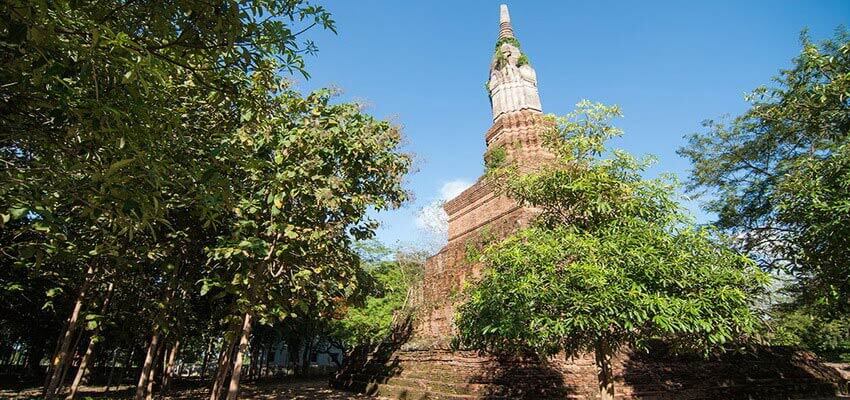
 Get to Kamphaeng Phet
Get to Kamphaeng Phet
Getting there: Park is located in the north of new Kamphaeng Phet city, near Ping River, about 80 km southwest of Sukhothai, 355 km north of Bangkok. To reach Kamphaeng Phet you can use plane, bus or private car. The nearest airport to Kamphaeng Phet is the Sukhothai Airport, 106 km away, from where you have to continue your journey by bus or taxi. Buses to Kamphaeng Phet from Bangkok leave from the Northern Mo Chit Terminal, with several departures during the day, the trip takes about 5 hours and the ticket costs from 220 to 280 THB, depending on the class. If you are already in Sukhothai the bus it is always the most convenient solution. The journey takes just over an hour and costs about 80 THB. Buses depart every 1-2 hours from the bus terminal on Jarot Withithong Road, in the north-west of Sukhothai. For the best bus stop in Kamphaeng Phet just ask the driver what it's better for the park.
Path Sukhothai - Kamphaeng Phet: to reach Kamphaeng Phet from Sukhothai by car, owned or rented, follow Highway 101 in direction southwest for 81 Km, the trip takes a little more of an hour. The car can easily be chartered in Sukhothai, about 1000-1300 THB per day. The rate of hiring a private taxi varies depending on your ability to bargain, roughly about 2500 THB for a whole day.
Find the best Hotel in Thailand at "Lowest Price"





